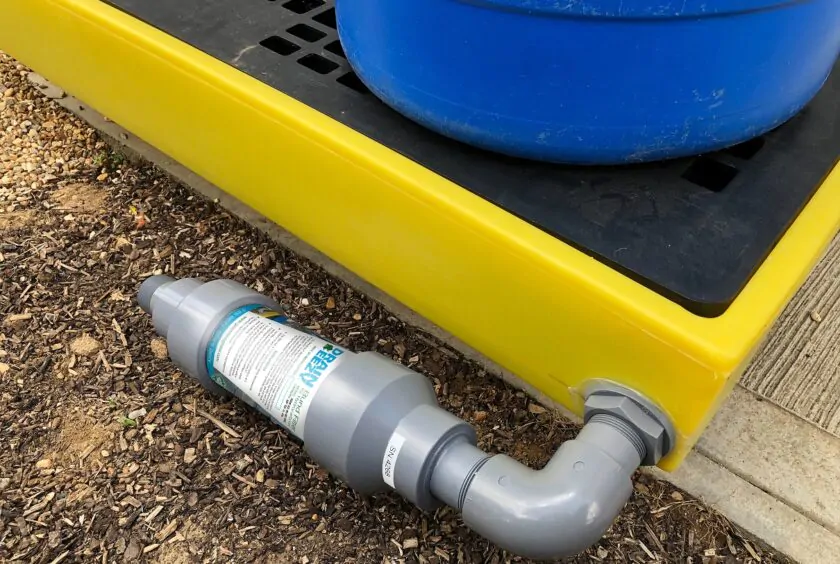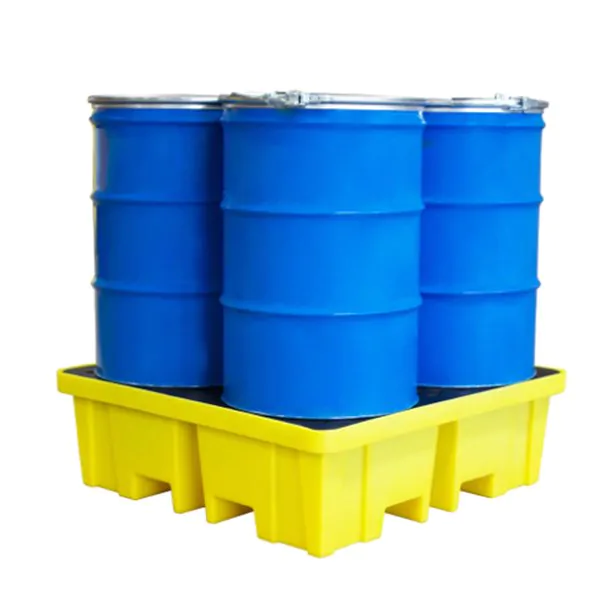Can You Port a Drainage Device to a Secondary Containment Bund? (UK)

Can you port a drainage device – like an oil removal filter – to a secondary containment bund? The answer depends on the volume of liquid you are storing and for how long.
We recently posted the image below on LinkedIn. It shows one of our DrainEezy Bund Filters fitted to a secondary containment bund outdoors.
The post focused on the issue of secondary containment bunds filling with rainwater. The rainwater mixes with any captured hydrocarbons to create a pool of contaminated water. This water should be disposed of responsibly but, in practice, is often left to overflow onto the ground – defeating the point of the bund in the first place.
The bund filter allows rainwater to drain freely while intercepting and neutralising any hydrocarbon contaminants.
The post received a tremendous amount of positive engagement which suggested that this is a common issue for which people are looking for a solution. However, it also sparked an interesting debate. Several people commented that this solution would contravene The Control of Pollution (Oil Storage) (England) Regulations 2001. Let’s clear this up.
Bulk storage outdoors
With some exclusions, the oil storage regulations apply to containers of 200 litres or more stored outdoors and state:
(2) The container must be situated within a secondary containment system which satisfies the following requirements—
(a)subject to paragraph (5), it must have a capacity of not less than 110% of the container’s storage capacity or, if there is more than one container within the system, of not less than 110% of the largest container’s storage capacity or 25% of their aggregate storage capacity, whichever is the greater;
…
(d)its base and walls must not be penetrated by any valve, pipe or other opening which is used for draining the system;
Note that this doesn’t apply where oil is temporarily stored for transportation on to another site.
A common storage container used for drums or IBCs is the bunded drum pallet (shown here). This satisfies the requirement of clause 2a in the regulations. However, if using bunded containers like this outdoors, you must have a system for ensuring that they don’t fill with rainwater and overflow.

The most obvious approach would be to place the containers inside a structure that keeps the rain out. Failing this, some kind of drainage system is required. Paragraph 2d of the regulations makes it clear, however, that the walls of the bund cannot be penetrated for drainage purposes. This rules out our DrainEezy Bund Filter.
This leaves two options:
- An oil/water separator system to pump water out of the bund and separate the oil for reuse or disposal.
- Emptying of the bund and disposal of the contaminated water by a third party waste contractor (e.g. by transferring the waste water to a hazardous waste bin or by using a vacuum tanker).
Both approaches require a rigorous monitoring regime to ensure that they are performed in a reliable and timely fashion. Otherwise, bunds will still overflow and the environment will be contaminated. Feedback from customers suggests that oil/water separators are notoriously unreliable and/or not maintained properly, often due to lack of resources or training.
Low volume outdoor storage
But applies only to bulk storage. Storing smaller containers on secondary containment, or storing larger containers temporarily on a bund, is not subject to the oil storage regulations. In these scenarios, oil removal filters are a highly effective and acceptable solution.
As always, it is incumbent upon you to ensure that filters are monitored and replaced once they have reached hydrocarbon capacity. You are still responsible for ensuring that contaminated rainwater does not escape from the bunds into the environment.
Should the oil storage regulations be updated?
We would argue that oil removal filters are just as effective as oil/water separators, easier to install, more reliable and a fraction of the cost. They can also generate less waste to dispose of.
It seems to us that the oil storage regulations and/or EA guidance could be updated along the following lines:
Any secondary containment systems used outdoors should be either
a) fitted with a roof to keep out rainfall,
b) fitted with an oil/water separator system, or
c) fitted with an adequately sealed drainage device which filters out contaminants to regulator-approved levels and which will automatically shut-off when it has reached capacity.
Any system employed must have an effective monitoring and maintenance regime in place.
Interest in our filters leads us to suspect that many companies do not want to install oil/water separators. This is possibly due to the total cost of ownership combined with the reliability issues. Oil removal filters offer an easy to install, low maintenance and low cost approach. Any solution which works and is well maintained has to be better than nothing.
However, customers should comply with the legislation as it stands.
Summary
You are responsible for ensuring that hazardous liquids stored or used on your premises and sites do not pollute the environment.
There are clear guidelines for how this should be achieved when storing liquids in bulk although the effectiveness of these measures can be heavily reliant on the monitoring and maintenance of spill control systems.
In lower volume/risk scenarios, there is more flexibility in the approach you can take including the use of oil removal filters like our DrainEezy range.
